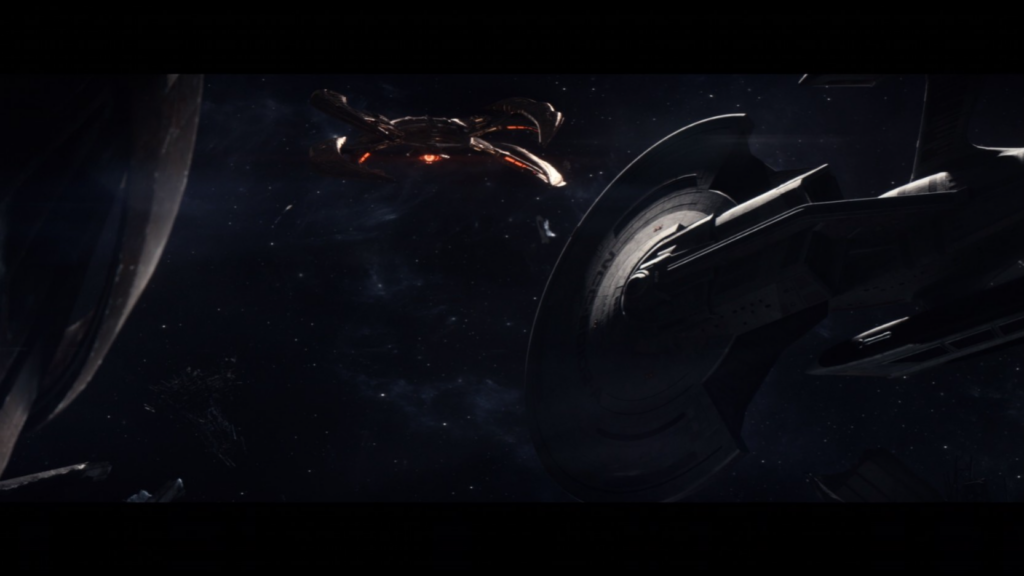I wasn’t sure what this episode was going to entail from the previews. I knew from the promotional material that at some point, Vadic and Co. was going to board the ship, and Sidney’s face would go up against a forcefield. That would be this episode, seven in, with three left remaining. While this week slowed down a bit to try and actually frame Vadic’s backstory, it still packed some serious emotional punches, and a few actual punches as well. But perhaps very frustratingly in a good way, it ended on a helluva cliffhanger, something you don’t often do until the penultimate episode.

The episode opens with a conversation between Seven and a familiar face, trying to find more allies in their efforts to expose the changeling corruption within the Federation. The Titan has been on the run now for nearly the entire show if you count its initial encounter with the Shrike, but especially the last four episodes. Jack Crusher is sort of our meta-conduit for this show, as a lot of his dialogue and demeanor sort of reflect what we viewers are kinda feeling and getting out of this. So when he comes in and starts asking Picard about his condition, and then gets frustrated and says they should take the fight to Vadic, it definitely felt very like a obvious-meta nod to us viewers. Stop running, confront the giggly lady, turn the tables. So they proceeded to do just that.

Prior to this, we’re treated to another Snoke Hand scene between Vadic and whomever she’s been working with, or for, who wants Jack. They stress the importance of fulfilling this plan before Frontier Day. No giggles, no bravado, she seems very concerned about this and communicates it on her face. If you had told me Amanda Plummer was to play some new random Trek villain, I would have not been so sure how it’d play out, but now knowing Vadic is a changeling, and an especially tortured one, she’s been a fantastic choice for the role. I only wish Rene Auberjonois were still alive to play Odo, the two of them would have been amazing. This is continued later in the episode with her backstory told to Picard and Beverly. Unfortunately, while it was a compelling story, a lot of little details were omitted likely so as not to confuse newer viewers who hadn’t watched Deep Space Nine. Taken at face, Vadic is an extremely complicated character born out of laboratory experiments, seeking revenge. It’s not really a particularly novel storyline, and I kinda wish that they had spent a little more time giving the viewer a better synopsis of how Section 31 and Julian Bashir’s involvement, along with Odo, was instrumental in how the virus and its cure helped end The Dominion War.
The other big elephant in the room was DataloreB4. Geordi and Alanna are still working on trying to make sense of this creation, but there were a few lines Geordi made about the totality and legacy of the Soongs that I thought really spoke to Trek as a whole, and especially Brent Spiner’s roles throughout the franchise. He’s a literal madman, playing Data, Lore, B4, and four different Soongs throughout history in various examples. The whole underpinning of Trek’s cybernetics and the ethics of both cybernetic enhancements and cybernetic beings was always something very pivotal to a show about the future. We are starting to have those discussions with transgenderism, but that builds on to what a utopian society would look like when humans are free to change anything and everything about themselves and still be functional contributions to society as a whole. However, it’s unlikely we’ll get this far with DataloreB4, as Lore especially isn’t the biggest fan of humanity.

Opening the episode with Tuvok was somewhat expected, but I did not know it would be him. The Ready Room teased a special guest for this week, and many thought it might be another DS9 face, but I was not prepared for Tuvok. I was, however, prepared for it to not actually be Tuvok, even though they juked us several times at the start. I was a little curious though why he was presented older than I thought he should be. He was 107 when he served on Voyager in 2371, making him 137 by this episode. Vulcans generally lived well past 200 years. Spock was born only 34 years prior to Tuvok, and was 139 when he had encountered the crew of the Enterprise-D in 2369. So I guess Spock was just less wear-for-tear in his back-half. Tim Russ’ brief performance was good though, with that evil wry smile after being sussed out. Hopefully the real Tuvok wasn’t killed, I really would hate for this show to off anymore beloved characters even for a good villain plot like this.

Vadic’s backstory, as I said above, it was good, but it could have been better if they were willing to dive deeper into DS9 lore for it. Sloan, Bashir, Odo, The Vorta, it’s a bit too simple to suggest that Starfleet, unaware of the massive ethical violations that Section 31 did with Odo, would then authorize further inhumane experiments. So either Section 31 continued without Sloan, or Starfleet had already been corrupted from the start, and The Founders allowed the torture of their own kind in order to advance their cause forward, fully knowing it would take upwards of thirty years to realize. Based on her weird hand friend she reports to, I do think Vadic has been played this entire time by either the true Founder playing the Star Wars Emperor card. Another interesting observation is her extremely tall bird-man, who seems to be the sort of closest confidant to her, had a spoken line, and seems much more resistant to weapons fire. Is he a changeling too, or something else? And is it possible that someone on the good guys’ side is actually within her organization, waiting to make a move perhaps next episode? This is where Rene Auberjonois;s Odo would have played a masterclass role in turning out to be a double-agent within Vadic’s group who turns on her at the last moment. I suppose they could still do this, either with CGI and voice clips, or a very convincing recast. I don’t think that will be the case, and I don’t think I’d want that anyway.

Jack and Sidney, this one gets a little more complicated. So they are explaining his hallucinations and superhuman feats as aspects of Picard’s disease. I don’t think that’s the case, and this week’s episode where he is now able to hear Sidney’s thoughts, and seemingly telepathically convince her or control her to do things, that treads into some lesser territory of changelings, namely telepathy. It’s not mentioned much in DS9, but in several episodes they note that changelings have telepathic abilities between themselves, and to a lesser extend the ability to project them outwards. Betazoids were known not to be able to read their thoughts, as Lwaxana Troi could not with Odo. However, The Trill were able to transfer memories into Odo during one of their rituals, suggesting that their telepathic abilities are similar. Between all this and Vadic’s suggestion that everyone will see who Jack really is, I am guessing he is going to be a changeling, or possess changeling traits through some kind of DNA splicing. The question is, was he replaced by a changeling at some point in his life and his mother is dumb, or was he experimented on unbeknown to her or anyone by either the changelings, Starfleet, or Section 31? I also don’t know how Picard’s body fits into this. They suggest that his body and Jack’s blood would create a perfect duplicate of him, which reinforces Jack’s DNA has been tampered with, but if they’ve been able to infiltrate a lot of Starfleet’s top echelon so far with even their imperfect replicas, why expend the extra effort for a perfect copy? Certainly it makes for a foolproof plan, it’s just we’re going through a lot of motions here in this execution, so it needs to really pay off for both the heroes and the villains to feel satisfying. It’s not like Picard S1 where there were no stakes because no one knew what they were in the first place, or Picard S2 where the concept of stakes are moot when Q is involved.

Finally, DataloreB4, or maybe mostly Lore this episode. We didn’t really know much about what Lore would do with this show, and seeing him as part of a quadfecta of personalities in one android body could have been interesting, until they kind of predictably went Loreways with it and had him take over the ship and let the enemy in. First off, well fucking done on your firewall work, Geordi. That’s on you. Second, Lore’s whole evil-mans shtick is honestly kind of contrived and old, like a worn-out roleplaying storyline. Boo fucking hoo, you were built first, became a psychopath, got shut down, and a better android replaced you. Then the next few times you were turned on and offered redemption, you went back on your bullshit once more, hoping to get that W, except the W was never defined very well, and that’s why you always lost, and ended up sharing a positronic brain with two of your cybernetic brothers and the memories of all your dead creators. Actual hell week.
Which is why it would have been a better turn of writing on this show to actually let Lore have a redemption arc. Perhaps he will in time, as Geordi alluded to the fact that the system he and Data inhabit seems designed to force them to co-exist. We have to remember that Data’s aspiration to be human includes being a shitty human, doing the wrong things, getting people hurt, or worse, and learning from them. Lore quips about survival, but doesn’t seem to think the changelings won’t just obliterate him once they’re done with everyone else. That’s always been his flaw throughout TNG, trusting others to hold him in higher regard when everyone is largely out for themselves, himself included. Data regains control towards the end, which I hope means something soon, because if we’re bringing Data back a second time and he just kinda stands to the side, I am going to be disappointed.
One final muse, I felt a little underwhelmed by Picard’s confrontation with Vadic. I didn’t want him to go all movie Kirk and be like MAH SOOOOOON but he just kind of old-man bumbled about, after having set this elaborate trap. He barely negotiated, barely got a word in edge-wise, and was then all set to just waste her in the end. I get the struggle with ethics and values both characters face, but I’d argue they discarded them a long time ago. To get to this point now, they have to be committed on breaking every law, bylaw, and directive, and let the chips fall as they may. That might seem like an Action Picard trope, but it’s really more a sign of having nothing to gain and nothing to lose. Hell, Geordi appealed with more emotion to Lore knowing full well Lore would never reciprocate.
Random Observations and Easter Eggs:
- Odo is once again alluded to as being the “one of us” who stole and brought the cure to The Great Link. The people who actually stole the cure from Section 31 were Miles O’Brien and Julian Bashir, who administered the cure to Odo, and he subsequently cured the Dominion changeling and the rest of the link when the Federation voted not to cure them thinking it would continue the war. Mind you, Odo was the one who was originally infected first by Section 31, who spread it to the other changeling and the rest unknown to either of them. Also having been tortured and prodded, Odo seems to be far more forgiving than our dear Vadic.
- No Raffi or Worf this week, though it was mentioned they were off gathering information on Riker’s whereabouts. Is he not on the Shrike still?
- The opening shot of the Titan in the Chin’toka Scrapyards is a reference to several DS9 episodes during the Dominion War where the Federation, Klingons, and Romulans fought the Jem’Hadar, Breen, and other Dominion ships in the Chin’toka system. The floating debris is no doubt the remains of mostly Federation ships lost to Breen energy weapons at the time.
- Data’s memories appear to have no record after the movie Nemesis as indicated by his mention of the Scimitar. So that would suggest his transfer to B4 was successful, but also means his actions after are unknown to Data. Lore’s comments about everyone being so old though were funny.
